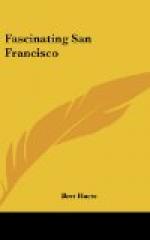The masts and yards of older outline have given place to stubby cargo booms of liners, freighters and tramps of multiple flags and nationalities. Along the Embarcadero they disgorge upon massive concrete piers silk, rice and tea from the Orient, coffee from Central America, hemp and tobacco from the Philippines, and all manner of odds and ends from everywhere. On the piers commodities are piled in apparent confusion, yet each lot moves with precision in or out of yawning holds at the shrill blast of the foreman’s hoist whistle.
Along the Embarcadero you may see craft of every rig under the sun from a Chinese junk to a Transpacific passenger liner. Human types are even more contrasting, knots of Chinese and Singalese strolling behind South Sea Islanders, Portuguese or Cornishmen, whose speech recalls snatches you may have heard on the East India Dock Road in London.
Jack London heard and answered the call of the sea from the Embarcadero of San Francisco, and Stevenson found the atmosphere of his Wreckers there.
Sailors—trade winds—ships—what lurking thoughts of adventure, realized or denied, do they not summon in all of us?
Historic Background
In 1579, before Jamestown, the Massachusetts Bay Colony, or New Amsterdam were settled, Sir Francis Drake, British explorer, careened and repaired his ship, the Golden Hind, on the shore of what is now Drake’s Bay, an indentation on the California coast just north of the Golden Gate. This was nearly two hundred years before Padre Junipero Serra led his band of zealots and soldiers up out of New Spain into Alta California.
At Drake’s Bay the chaplain of the Golden Hind held the first religious service in the English language on the American continent—a service that is commemorated by a Celtic cross set up on a hill in Golden Gate Park, San Francisco. Though close by, Drake did not find the Bay and site of San Francisco.
It was not until October 31, 1769, that the peninsula and Bay of San Francisco were discovered by an expedition headed by Don Gaspar de Portola, Governor of Baja or Lower California. This expedition had set out overland from San Diego for the purpose of locating Monterey Bay, discovered in 1603 by Sebastian Vizcaino, Portuguese navigator in the service of Spain.
Six years after the Portola discovery, Don Juan Manuel Ayala sailed the first vessel, the San Carlos, through the Golden Gate. The following year the first permanent settlement by white men on the site of San Francisco was made when Colonel Juan Bautista de Anza established a military post at the Presidio beside the Golden Gate. In this same month, July, 1776, the Liberty Bell was ringing in Philadelphia. But there was no thought then that the embattled farmers of the Atlantic coast should inherit before many years this potential Spanish settlement on the Pacific.
In October, 1776, Padre Junipero Serra founded the Mission Dolores, the third of the chain of missions extending from San Diego. Subsequently a settlement was made at Yerba Buena Cove, and there was established the pueblo of Yerba Buena which has grown into the city of San Francisco.




